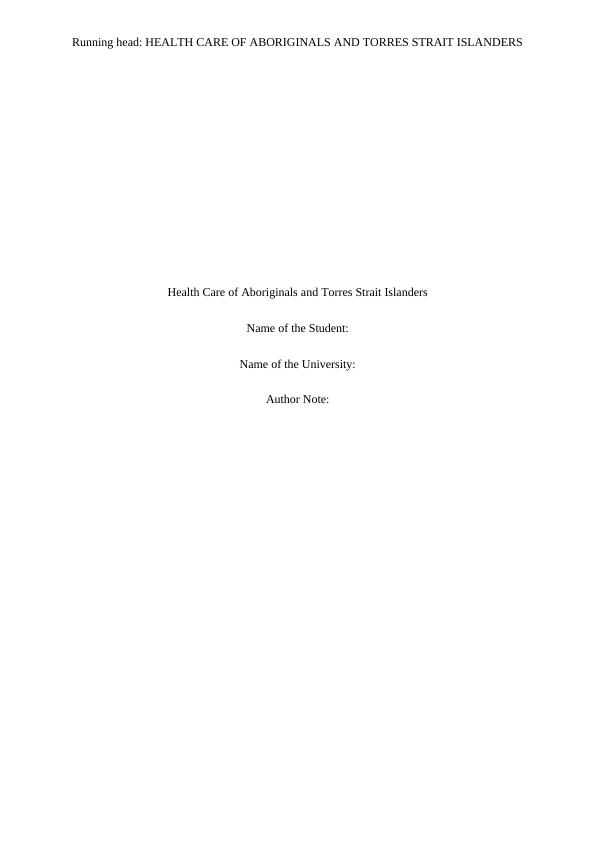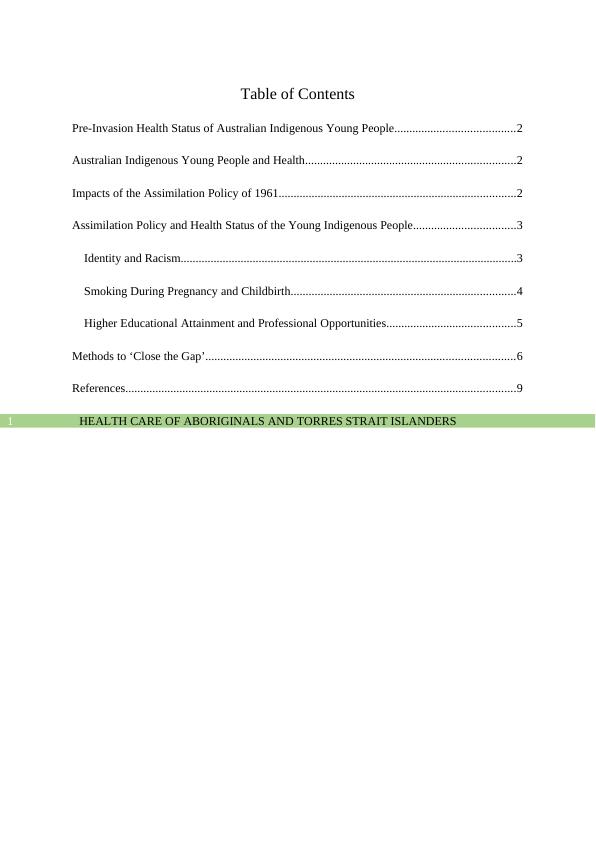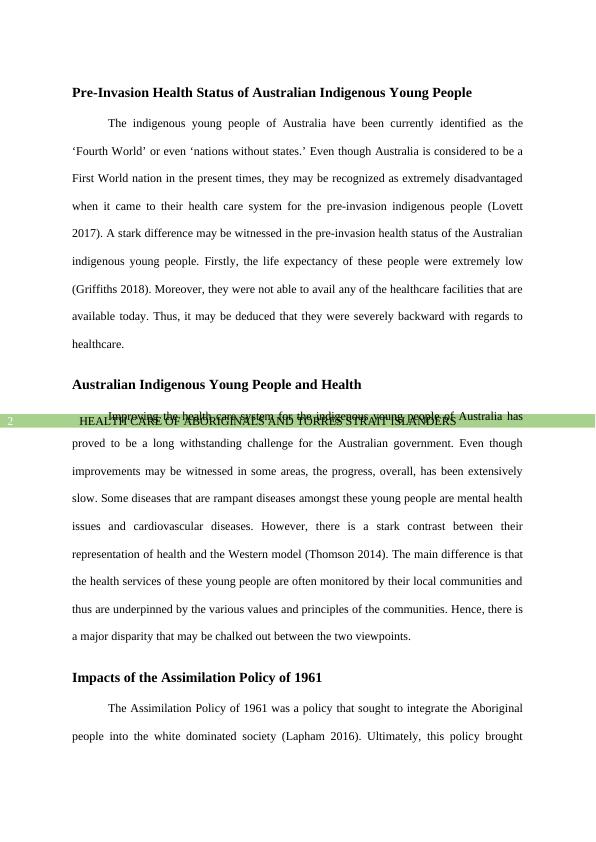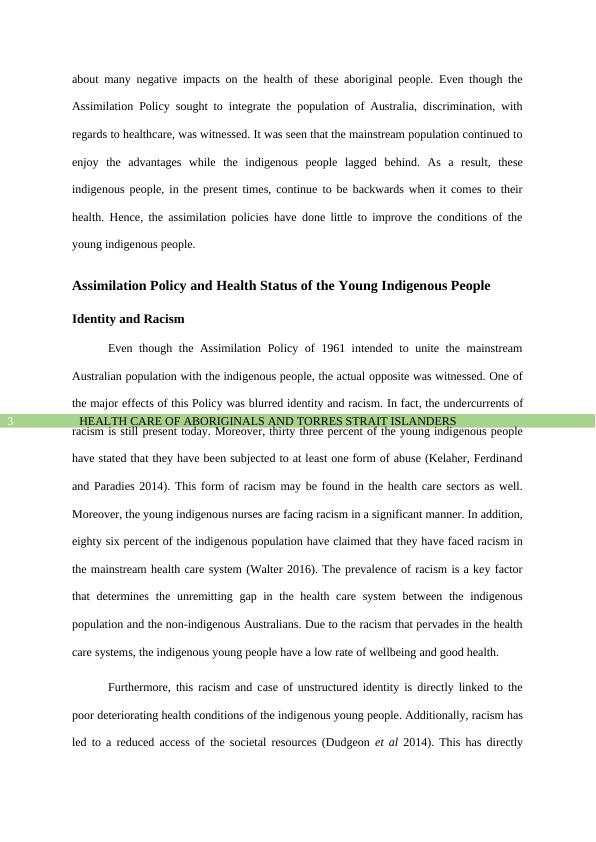Health Care of Aboriginals and Torres Strait Islanders
Added on 2022-12-18
12 Pages3195 Words7 Views
Running head: HEALTH CARE OF ABORIGINALS AND TORRES STRAIT ISLANDERS
Health Care of Aboriginals and Torres Strait Islanders
Name of the Student:
Name of the University:
Author Note:
Health Care of Aboriginals and Torres Strait Islanders
Name of the Student:
Name of the University:
Author Note:

HEALTH CARE OF ABORIGINALS AND TORRES STRAIT ISLANDERS1
Table of Contents
Pre-Invasion Health Status of Australian Indigenous Young People........................................2
Australian Indigenous Young People and Health......................................................................2
Impacts of the Assimilation Policy of 1961...............................................................................2
Assimilation Policy and Health Status of the Young Indigenous People..................................3
Identity and Racism................................................................................................................3
Smoking During Pregnancy and Childbirth...........................................................................4
Higher Educational Attainment and Professional Opportunities...........................................5
Methods to ‘Close the Gap’.......................................................................................................6
References..................................................................................................................................9
Table of Contents
Pre-Invasion Health Status of Australian Indigenous Young People........................................2
Australian Indigenous Young People and Health......................................................................2
Impacts of the Assimilation Policy of 1961...............................................................................2
Assimilation Policy and Health Status of the Young Indigenous People..................................3
Identity and Racism................................................................................................................3
Smoking During Pregnancy and Childbirth...........................................................................4
Higher Educational Attainment and Professional Opportunities...........................................5
Methods to ‘Close the Gap’.......................................................................................................6
References..................................................................................................................................9

HEALTH CARE OF ABORIGINALS AND TORRES STRAIT ISLANDERS2
Pre-Invasion Health Status of Australian Indigenous Young People
The indigenous young people of Australia have been currently identified as the
‘Fourth World’ or even ‘nations without states.’ Even though Australia is considered to be a
First World nation in the present times, they may be recognized as extremely disadvantaged
when it came to their health care system for the pre-invasion indigenous people (Lovett
2017). A stark difference may be witnessed in the pre-invasion health status of the Australian
indigenous young people. Firstly, the life expectancy of these people were extremely low
(Griffiths 2018). Moreover, they were not able to avail any of the healthcare facilities that are
available today. Thus, it may be deduced that they were severely backward with regards to
healthcare.
Australian Indigenous Young People and Health
Improving the health care system for the indigenous young people of Australia has
proved to be a long withstanding challenge for the Australian government. Even though
improvements may be witnessed in some areas, the progress, overall, has been extensively
slow. Some diseases that are rampant diseases amongst these young people are mental health
issues and cardiovascular diseases. However, there is a stark contrast between their
representation of health and the Western model (Thomson 2014). The main difference is that
the health services of these young people are often monitored by their local communities and
thus are underpinned by the various values and principles of the communities. Hence, there is
a major disparity that may be chalked out between the two viewpoints.
Impacts of the Assimilation Policy of 1961
The Assimilation Policy of 1961 was a policy that sought to integrate the Aboriginal
people into the white dominated society (Lapham 2016). Ultimately, this policy brought
Pre-Invasion Health Status of Australian Indigenous Young People
The indigenous young people of Australia have been currently identified as the
‘Fourth World’ or even ‘nations without states.’ Even though Australia is considered to be a
First World nation in the present times, they may be recognized as extremely disadvantaged
when it came to their health care system for the pre-invasion indigenous people (Lovett
2017). A stark difference may be witnessed in the pre-invasion health status of the Australian
indigenous young people. Firstly, the life expectancy of these people were extremely low
(Griffiths 2018). Moreover, they were not able to avail any of the healthcare facilities that are
available today. Thus, it may be deduced that they were severely backward with regards to
healthcare.
Australian Indigenous Young People and Health
Improving the health care system for the indigenous young people of Australia has
proved to be a long withstanding challenge for the Australian government. Even though
improvements may be witnessed in some areas, the progress, overall, has been extensively
slow. Some diseases that are rampant diseases amongst these young people are mental health
issues and cardiovascular diseases. However, there is a stark contrast between their
representation of health and the Western model (Thomson 2014). The main difference is that
the health services of these young people are often monitored by their local communities and
thus are underpinned by the various values and principles of the communities. Hence, there is
a major disparity that may be chalked out between the two viewpoints.
Impacts of the Assimilation Policy of 1961
The Assimilation Policy of 1961 was a policy that sought to integrate the Aboriginal
people into the white dominated society (Lapham 2016). Ultimately, this policy brought

HEALTH CARE OF ABORIGINALS AND TORRES STRAIT ISLANDERS3
about many negative impacts on the health of these aboriginal people. Even though the
Assimilation Policy sought to integrate the population of Australia, discrimination, with
regards to healthcare, was witnessed. It was seen that the mainstream population continued to
enjoy the advantages while the indigenous people lagged behind. As a result, these
indigenous people, in the present times, continue to be backwards when it comes to their
health. Hence, the assimilation policies have done little to improve the conditions of the
young indigenous people.
Assimilation Policy and Health Status of the Young Indigenous People
Identity and Racism
Even though the Assimilation Policy of 1961 intended to unite the mainstream
Australian population with the indigenous people, the actual opposite was witnessed. One of
the major effects of this Policy was blurred identity and racism. In fact, the undercurrents of
racism is still present today. Moreover, thirty three percent of the young indigenous people
have stated that they have been subjected to at least one form of abuse (Kelaher, Ferdinand
and Paradies 2014). This form of racism may be found in the health care sectors as well.
Moreover, the young indigenous nurses are facing racism in a significant manner. In addition,
eighty six percent of the indigenous population have claimed that they have faced racism in
the mainstream health care system (Walter 2016). The prevalence of racism is a key factor
that determines the unremitting gap in the health care system between the indigenous
population and the non-indigenous Australians. Due to the racism that pervades in the health
care systems, the indigenous young people have a low rate of wellbeing and good health.
Furthermore, this racism and case of unstructured identity is directly linked to the
poor deteriorating health conditions of the indigenous young people. Additionally, racism has
led to a reduced access of the societal resources (Dudgeon et al 2014). This has directly
about many negative impacts on the health of these aboriginal people. Even though the
Assimilation Policy sought to integrate the population of Australia, discrimination, with
regards to healthcare, was witnessed. It was seen that the mainstream population continued to
enjoy the advantages while the indigenous people lagged behind. As a result, these
indigenous people, in the present times, continue to be backwards when it comes to their
health. Hence, the assimilation policies have done little to improve the conditions of the
young indigenous people.
Assimilation Policy and Health Status of the Young Indigenous People
Identity and Racism
Even though the Assimilation Policy of 1961 intended to unite the mainstream
Australian population with the indigenous people, the actual opposite was witnessed. One of
the major effects of this Policy was blurred identity and racism. In fact, the undercurrents of
racism is still present today. Moreover, thirty three percent of the young indigenous people
have stated that they have been subjected to at least one form of abuse (Kelaher, Ferdinand
and Paradies 2014). This form of racism may be found in the health care sectors as well.
Moreover, the young indigenous nurses are facing racism in a significant manner. In addition,
eighty six percent of the indigenous population have claimed that they have faced racism in
the mainstream health care system (Walter 2016). The prevalence of racism is a key factor
that determines the unremitting gap in the health care system between the indigenous
population and the non-indigenous Australians. Due to the racism that pervades in the health
care systems, the indigenous young people have a low rate of wellbeing and good health.
Furthermore, this racism and case of unstructured identity is directly linked to the
poor deteriorating health conditions of the indigenous young people. Additionally, racism has
led to a reduced access of the societal resources (Dudgeon et al 2014). This has directly

End of preview
Want to access all the pages? Upload your documents or become a member.
Related Documents
Australian Government Healthcare Systemlg...
|12
|3069
|15
Aboriginal and Torres Strait Island Culture PDFlg...
|11
|3107
|207
Impact of Health Policies on Indigenous Australians in Australialg...
|9
|2623
|239
Policy of Assimilation 1961: Impact on Health Outcomes of Australian Indigenous Young Peopleslg...
|13
|3460
|255
Aboriginal Healthlg...
|11
|2994
|260
Healthcare for Australian Indigenous Elderslg...
|12
|3044
|359
